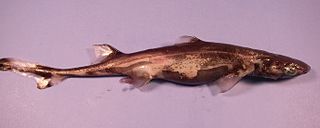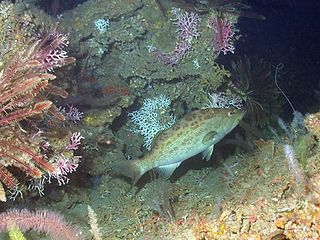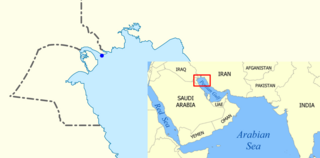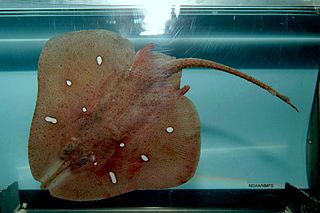
The Atlantic threadfin is a species of ray-finned fish, a threadfin from the family Polynemidae native to subtropical and temperate waters of the western Atlantic Ocean and the Gulf of Mexico.

The blurred lanternshark is a little-known species of dogfish shark in the family Etmopteridae, found around the world in benthic and pelagic habitats from a depth of 110 m (360 ft) to over 1 km (0.62 mi) down. This shark forms the E. pusillus species group with the smooth lanternshark, which are distinguished from other members of its family by having irregularly arranged, flat-topped dermal denticles that give them a "smooth" appearance. Both species are slender-bodied with long heads, two dorsal fins bearing spines, no anal fins, and light-emitting photophores. The blurred lanternshark is larger, reaching 67 cm (26 in) or more in length. This species feeds on small squid, fishes, and fish eggs, and is ovoviviparous. It has been assessed as of Least Concern by the International Union for Conservation of Nature, because of its wide distribution and lack of threat from fishing pressure.

The green lanternshark is a species of dogfish shark in the family Etmopteridae, found in the western central Atlantic Ocean. This species usually occurs on the upper continental slope below a depth of 350 m (1,150 ft). Reaching 26 cm (10 in) in length, the green lanternshark has a slender body with a long, thin tail and low, conical dermal denticles on its flanks. It is dark brown or gray with ventral black coloration, which contain light-emitting photophores that may serve a cryptic and/or social function. Green lanternsharks are thought to be gregarious and may attack their prey, squid and octopus often larger than themselves, in packs. Reproduction is aplacental viviparous, with females giving birth to litters of one to three young. This relatively common shark is an occasional, valueless bycatch of commercial fisheries; currently it does not appear to be significantly threatened by human activities.

Dipturus is a large genus of skates native to the Pacific, Atlantic, and Indian Oceans. They were formerly included in Raja. Some species initially moved to Dipturus were later placed in Dentiraja, Spiniraja, and Zearaja.

The barndoor skate is a species of marine cartilaginous fish in the skate family Rajidae of the order Rajiformes. It is native to the northwestern Atlantic Ocean, and is found from the Grand Banks of Newfoundland and the southern side of the Gulf of St. Lawrence south to North Carolina. The fish is one of the largest skates found in the North Atlantic Ocean, reaching lengths up to 1.5 m (5 ft). It is carnivorous, feeding on invertebrates and other fish found near the sea floor.

The longnose stingray is a species of stingray in the family Dasyatidae, native to the western Atlantic Ocean from the southern Gulf of Mexico to Brazil. Found in coastal waters no deeper than 36 m (118 ft), this demersal species favors muddy or sandy habitats. The longnose stingray is characterized by its angular, rhomboid pectoral fin disc, moderately projecting snout, and whip-like tail with a dorsal keel and ventral fin fold. It typically grows to 1.25 m (4.1 ft) across and is brownish above and light-colored below.

The ocellated electric ray or bullseye electric ray is a species of electric ray in the family Narcinidae, native to the shallow inshore waters of the eastern central Pacific from the Gulf of California to Ecuador. Reaching 25 cm (9.8 in) in length, this species has a rounded pectoral fin disc and pelvic fins with convex margins. Its short and thick tail bears two dorsal fins and terminates in a triangular caudal fin. The ocellated electric ray is named for the distinctive large eyespot on the middle of its disc, consisting of a black or yellow center surrounded by concentric rings. Its dorsal coloration is otherwise highly variable, ranging from plain to ornately patterned on a light to dark brown background. The front part of its disc is darker brown.

The thornback ray, or thornback skate, is a species of ray fish in the family Rajidae.

The roughtail stingray is a species of stingray in the family Dasyatidae, with separate populations in coastal waters of the northwestern and southwestern Atlantic Ocean. This bottom-dwelling species typically inhabits sandy or muddy areas with patches of invertebrate cover, at a depth of 15–50 m (49–164 ft). It is seasonally migratory, overwintering in offshore waters and moving into coastal habitats for summer. The largest whip-tail stingray in the Atlantic, the roughtail stingray grows up to 2.6 m (8.5 ft) across and 360 kg (800 lb) in weight. It is plain in color, with an angular, diamond-shaped pectoral fin disc and a long, whip-like tail bearing a subtle fin fold underneath. The many thorns on its back and tail serve to distinguish it from other stingrays that share its range.

The belted cardinalfish is a tropical marine fish in the genus Apogon. They grow up to 6.5 centimetres (2.6 in) in length. Belted cardinalfish are found in the waters of the western Atlantic Ocean, off Central and South America, inhabiting caves and holes. They are pinkish-red on the dorsal side and yellowish-red on the ventral side. Their eggs are carried in the mouth of the adult as they mature.

Fenestraja is a genus of eight species of skate in the family Gurgesiellidae. They are found in deeper waters of the western Atlantic and the Indian Ocean.

The scamp grouper, also known as scamp, is a species of marine ray-finned fish, a grouper from the subfamily Epinephelinae which is part of the family Serranidae, which also includes the anthias and sea basses. It is found in the western Atlantic Ocean.

Menticirrhus saxatilis, the northern kingfish or northern kingcroaker, is a species of marine fish in the family Sciaenidae. It lives in the shallow coastal waters of the western Atlantic Ocean and Gulf of Mexico.

The clearnose skate is a species of cartilaginous fish in the family Rajidae. R. eglanteria is also known by other common names such as the brier skate and summer skate. Clearnose skates are easily identified by the translucent patches on either side of their snouts and their mottled dorsal surface. They are found along the Atlantic and Gulf coasts of the United States in shallow waters of the continental shelf.

The pita skate is a medium-sized skate in the family Rajidae. The holotype and only known specimen was found in the northern Persian Gulf, in Iraqi waters. It was collected at a depth of less than 15 m (49 ft).

The hook skate or Clark's fingerskate is a medium-sized, but poorly known, deepwater skate." Its distribution is considered patchy and covers the western central and southwest Atlantic, including the east coast of Florida, throughout the Gulf of Mexico, and off Rio Grande do Sul.

Raja straeleni, the biscuit skate, false thornback skate, or spotted skate, is a species of marine fish in the skate family of order Rajiformes. It is native to the eastern Atlantic Ocean.

Fenestraja plutonia is a species of cartilaginous fish in the family Gurgesiellidae. It is commonly known as the underworld windowskate or Pluto pygmy skate. The underworld windowskate is known from patches of continental slope in the western Atlantic Ocean between the coasts of the southern United States and Suriname.

Raja stellulata, commonly known as the Pacific starry skate, rock skate, prickly skate, or starry skate, is a species of cartilaginous fish in the family Rajidae. It is found on rocky bottoms at 18–982 m depths in the Northeast and Eastern Central Pacific, from Coronado Bank in northern Baja California in Mexico to Barkley Sound in British Columbia, Canada. Females reach a maximum total length of 76.1 cm and a maximum age of 15 years, while males can be up to 71.7 cm long and live up to 14 years; the total length at birth is 15.5–22.5 cm. This skate prefers cold water with a temperature of 4.1–11.6°C.



















